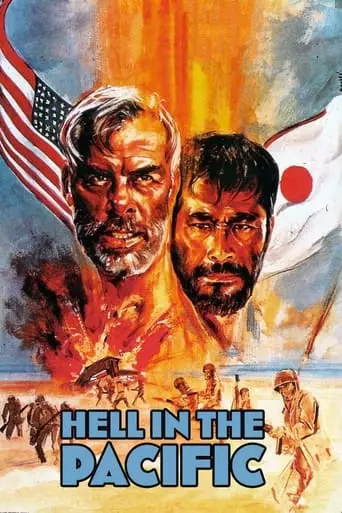
Hell in the Pacific (1968) Watch Online Free
During World War II, a shot-down American pilot and a marooned Japanese navy captain find themselves stranded on the same small uninhabited island in the Pacific Ocean.
Hell in the Pacific is a tense World War II survival drama that focuses on the unlikely bond between two soldiers stranded on a remote Pacific island. Lee Marvin plays an American pilot who is shot down and washes ashore, only to encounter Toshiro Mifune’s character, a Japanese naval officer. Initially, the two engage in a hostile standoff, continuing the war on a micro-scale. Their relationship oscillates between conflict and uneasy cooperation as they struggle to survive on the island with limited resources. Despite their efforts to kill each other at first, they gradually learn to work together, building a raft in an attempt to escape. However, the brutal realities of war, isolation, and cultural differences continue to influence their interactions, leading to a poignant and ambiguous conclusion about friendship, survival, and the futility of war.
The film explores themes of survival, human dignity, and the absurdity of war. Set against the backdrop of WWII, it emphasizes the futility of conflict and the human need for connection in even the most dire circumstances. The central theme revolves around the idea of “enemy” and the blurred lines between adversaries who must cooperate to stay alive. The lack of communication—compounded by language barriers—symbolizes the distance and mistrust between the soldiers, making their eventual truce and cooperation even more significant.
Director John Boorman uses minimalistic dialogue and naturalistic settings to highlight the isolation and intense emotional and physical toll of war. The film reflects on the personal struggles of the soldiers as individuals, emphasizing how their cultural identities and wartime ideologies dissolve in the face of shared human needs.
Hell in the Pacific has had a lasting impact as an anti-war film. Its focus on personal survival and the breakdown of enemy stereotypes challenges conventional wartime narratives that glorify combat. The film stands out in the genre by not just portraying soldiers as mere instruments of war but as complex individuals whose humanity transcends national identity. By showing the gradual shift from animosity to cooperation, it underscores the emotional and psychological toll war inflicts on people, regardless of side.
The film is also notable for its minimalistic approach to storytelling, using the isolation of the setting and the sparse dialogue to convey the internal conflict of the characters. This stylistic choice enhances the movie’s contemplative nature and reflects the isolation felt by soldiers on both sides of the conflict. Hell in the Pacific is both a commentary on the personal cost of war and a critique of the broader societal forces that drive it.
After watching Hell in the Pacific, you will likely feel a mix of melancholy and contemplation. The film’s somber tone and ambiguous ending may leave you reflecting on the futility of war, the nature of human conflict, and the possibility of connection between individuals who are divided by ideology and circumstance. The powerful performances of Marvin and Mifune will evoke empathy, as you witness two adversaries struggling not only to survive but to find some form of understanding in an environment that strips away everything except their basic humanity. Ultimately, you may feel moved by the film’s anti-war message and its reminder of the fragility of life and the bonds that can form even under the most hostile conditions
